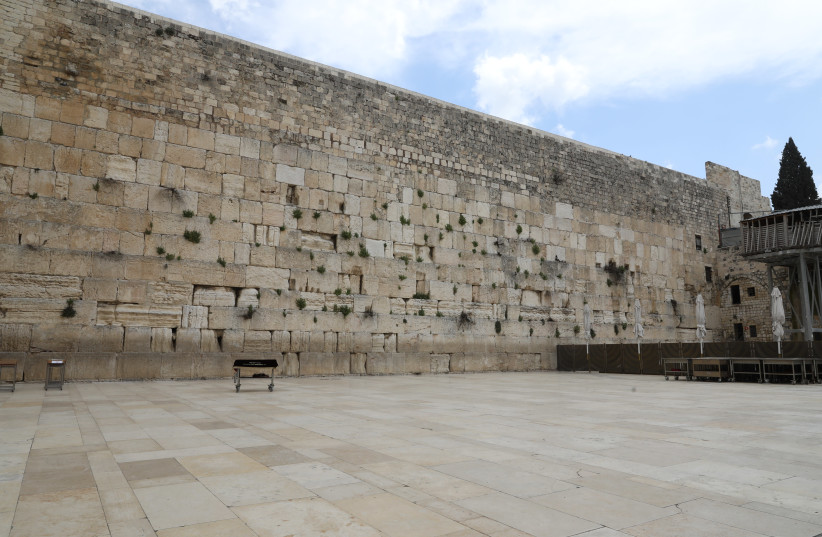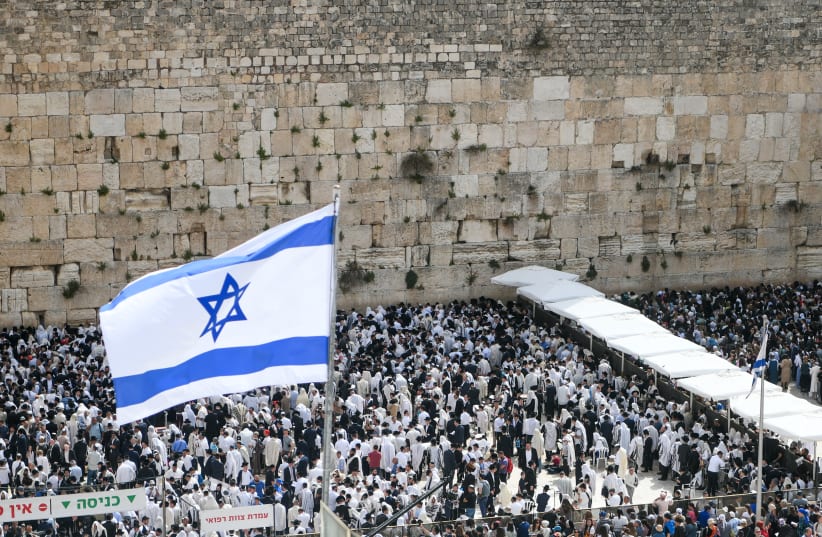Sometimes a picture is worth a thousand words. In the age of photography, often an epic event is best captured by an iconic photo.
The Six Day War was a grand historical shift. God created His natural world in six days, and He recreated modern Jewish history in six days of June. Everything changed. This drama, which played out in less than a week, contained fabled heroes, military legends and diplomatic dramas, but most unforgettably, one iconic image. The image of three paratroopers standing at the Western Wall, eyes raised toward Heaven, etched itself in our collective memory.
For thousands of years, we were scattered across time, yet we all prayed to one common location. God had departed Jerusalem, but He remained hidden behind the Western Wall, listening to our prayers and patiently awaiting the reconstruction of history. In 1967, He emerged from behind His Wall and reconstituted His relationship with His people.
The year 1948, despite its great euphoria, still felt historically hollow. We received carved up slices of land, geographically disjointed and barely defensible. Most importantly, we were still barred from Jerusalem and its historic environs. In 1967, we returned to the heartland of biblical Israel and, of course, to our long-abandoned capital and its silent Wall. This return suffused our land with prophetic spirit, redemptive expectations and national pride.
The energy and excitement in Jerusalem radiated to Jews across the globe. Millions of Russian Jews had been frozen out of Jewish identity by the repressive Soviet regime. In 1967 the ice started to thaw, and Russian Jews began their long march home. The passion in Jerusalem rippled northward to Moscow.


Likewise, after 1967, Jews in Western countries underwent a renaissance of Jewish pride and identity. In the wake of the Holocaust, having secured safe havens in the West, Jews were private about their religion, uncomfortable with displaying their Judaism in public, and afraid of rocking the boat. Living in survival mode, they were unconfident and uneasy about asserting themselves in broader society. The 1967 victory in Jerusalem restored Jewish pride in New York and London, empowering Jews with greater confidence and emboldening them to both publicly display Jewish identity and to participate more assertively in general society. The aftermath of 1967 brought prophetic spirit, national pride and historical awakening, and one famous picture captured it all. A picture really is worth a thousand words.
Equally important, 1967 was a period of national unity. Having faced an existential threat to our fledgling nation, we were united through our remarkable victory. Our spectacular return to the Western Wall roused the imagination of the entire Israeli population, from secular to religious. Something about Jerusalem captured our collective imagination, regardless of religious affiliation. We all felt united.
Jerusalem has always possessed this capacity. It was the only territory in ancient Israel which wasn’t allocated to a particular tribe, so that no one sector would appropriate religion as its own. Jerusalem became a shared commonwealth, emphasizing that there is no monopoly to the word of God or to His presence. Unlike the rest of the country, which was settled prior to Jewish monarchy, Jerusalem was inhabited by Jews only after King David ascended the throne. Having achieved centralized government, they could now install Jerusalem as a federal district rather than as a tribal borough.
In 1967, the ancient city of Jewish unity once again unified our people. We stood before the Wall as one.
Sadly, the common consensus surrounding the Wall has become brittle. The Kotel is slowly morphing into the private domain of religious Jews.
Polarized politics
In our radically polarized political setting, people affiliate with a political group, often thoughtlessly adopting positions that are espoused by their “camp.” This creates a dynamic of “politics of appropriation,” where one group appropriates a broad issue or value, which should, ideally, be a consensus policy. In our environment of political antagonism, often one camp reflexively rejects a value simply because its political adversary has adopted it. Consensus issues, which should unify us, become splintered along sectarian lines.
For example, during the recent political crisis, opponents of judicial reform claimed that these bills and measures were undemocratic. There are many reasons to oppose the reforms, just as there are many justifications to support them, but labeling them “undemocratic” is platitudinous and intellectually dishonest. The reforms aim to calibrate the delicate balance of power vital to any democracy. Without healthy checks and balances, democracy will crumble. This is not a face-off between supporters of democracy and fascists but a dispute about how to best construct durable democracy.
Similarly, the issue of social justice has become unintentionally appropriated by secular Israel. Its devotion to social justice and to battling social discrimination is noteworthy. Sadly, many religious Jews recoil from this social agenda simply because secular Israel has championed it. Social justice is a vital feature of religious identity and should be a national bipartisan agenda. This is just another example of the sad cost of polarized politics: If my political adversary has adopted a platform, I must automatically reject it without properly considering its merit.
A religious Wall?
I worry that the Western Wall is being unintentionally appropriated by religious Jews. Religious rituals, and prayer in particular, provide religious Jews with an organic connection to the Wall which secular Jews don’t always have. Further exacerbating the situation, the Wall, aside from being a national and historical monument, is also a functioning site of prayer which requires strict standards, including separation between the sexes. Orthodox Jews cannot relax these standards, yet non-Orthodox Jews and secular Jews are accustomed to mixed prayer experiences. This puts, or should put, Orthodox Jews in a bind. They can’t relax their halachic standards, but just the same, how can they exclude non-Orthodox Jews from such an essential part of our national heritage?
Sincere attempts to formulate creative solutions have so far failed due, in many cases, to political pettiness and historical myopia. Though there is no easy solution, the Kotel dilemma should haunt every Orthodox Jew. It is not more religious to make the Kotel less accessible. Just because there are no easy answers doesn’t mean Orthodox Jews can simplistically ignore the problem.
Additionally, the rising popularity of visiting the Temple Mount has deepened the affiliation between the mountain, its Wall, and the religious sector. There are many valid reasons to visit the Temple Mount, just as there are solid reasons not to. Sadly, though, the experience has become deeply politicized. Government officials routinely visit, not only as a religious pilgrimage but also to assert political positions. As Temple Mount visits become politicized, they also polarize public attitudes. Unfortunately, those who question the merit or wisdom of Temple Mount visits under the current circumstances, sometimes become alienated from the Temple Mount. As the Temple Mount becomes polarized and solely the province of the religious, is the nearby Kotel similarly transitioning into a purely religious site rather than a national treasure and a Wall of unity? Whether you support or oppose visiting the Temple Mount, this alienation is worrying.
Is the Kotel of 1967 still standing? Would the picture of three paratroopers still resonate? I certainly hope so, but I fear that without thought and creative solutions, that historic picture will fade from our national consciousness. If it does, we will have squandered one of God’s gifts of 1967.
The writer is a rabbi at Yeshivat Har Etzion/Gush, a hesder yeshiva. He has smicha and a BA in computer science from Yeshiva University, as well as a master’s degree in English literature from the City University of New York.
